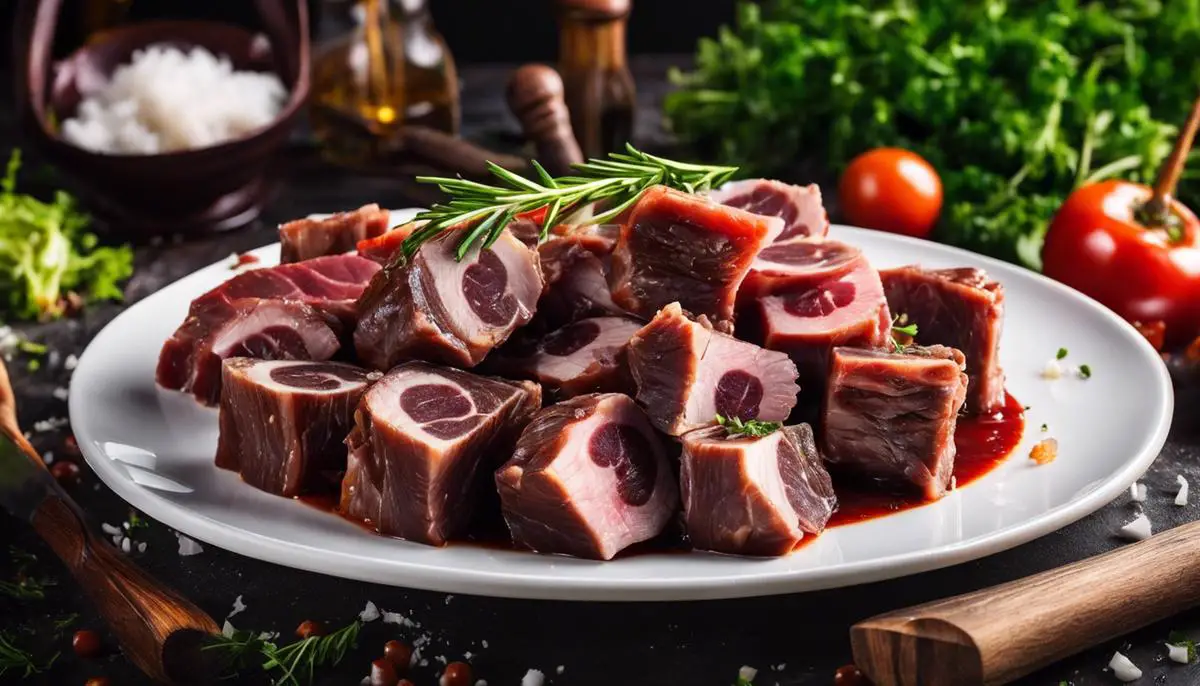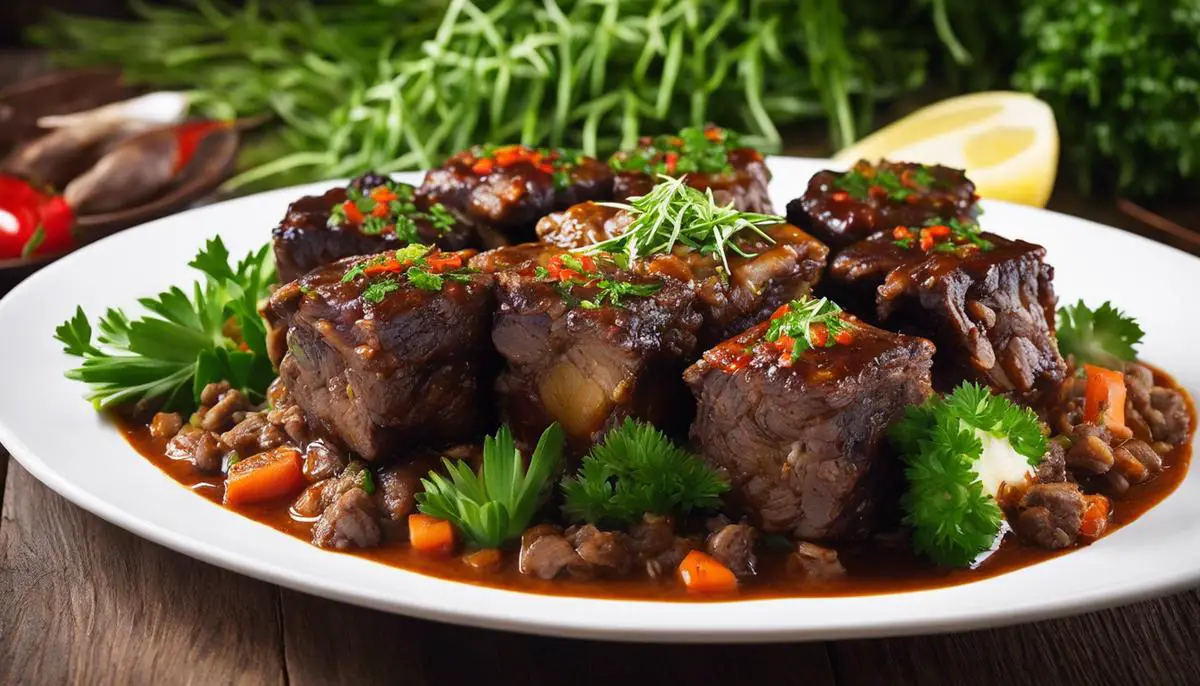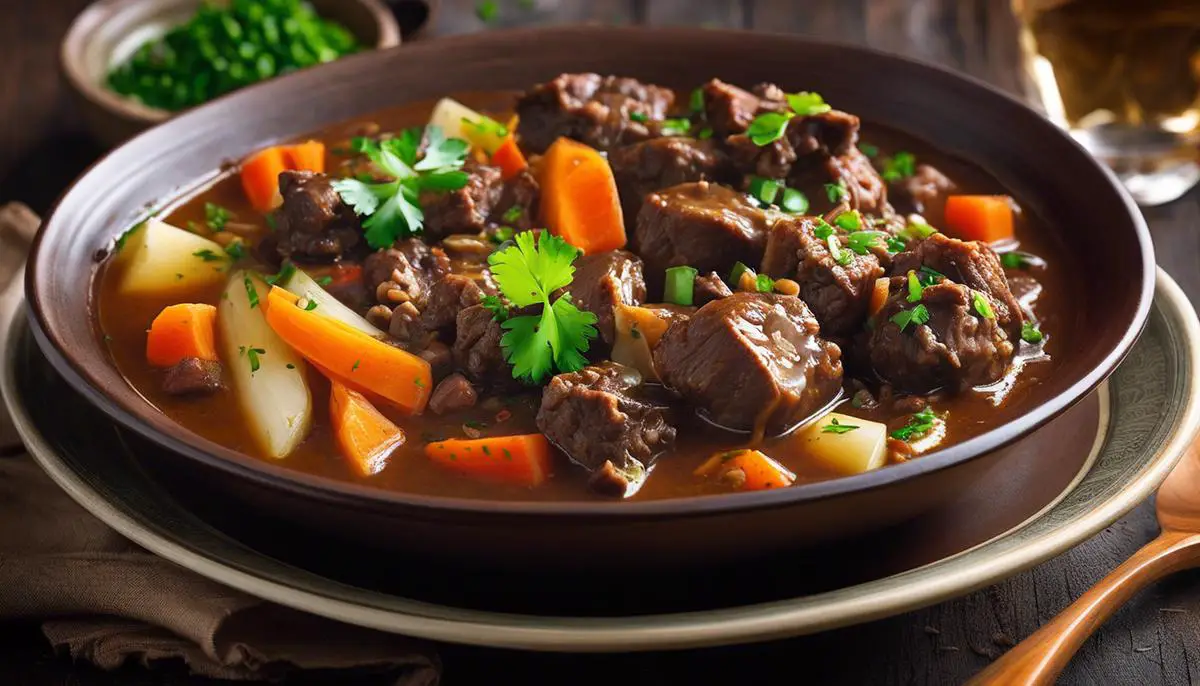
Embarking on the culinary journey of creating a hearty oxtail stew is an experience that transcends everyday cooking. This savory dish, rooted in tradition and brimming with rich flavors, begins with the art of selecting and preparing the oxtail. Understanding the importance of quality cuts and the meticulous process of cleaning, trimming, and preparation is crucial before one even starts to think about cooking. The transformation of oxtail from a tough piece of meat to a tender, succulent foundation of your stew is an alchemy that requires both patience and skill. As you continue to learn more about this exquisite dish, we will uncover the secrets of browning the meat to perfection, and meticulously crafting a stew base that embodies the essence of comfort food—a slow-simmered symphony of tastes and aromas that promise to enchant your senses.
Preparation of Oxtail
The Art of Prepping Oxtail – Your Gateway to Hearty Comfort!
Warm greetings to all the culinary adventurers out there! Ever find yourself in a cooking rut, looking to spice up your kitchen routine with some succulent, fall-off-the-bone meat treat? Look no further than the unassuming, yet oh-so-delicious oxtail! Often overlooked in mainstream dining, this gem of a cut is a staple in a myriad of global cuisines, recognized for its rich flavor and luscious texture.
Now, if you’re gearing up to give this hearty hunk of meat a whirl, here’s your essential guide to prepping oxtail that’ll ensure every spoonful is infused with soul-warming deliciousness:
Step 1: Thaw Thy Oxtail!
If your oxtail is frozen, patience is key. Place it in the fridge and give it ample time to thaw completely. Rushing this process could result in uneven cooking later, and who wants a culinary misadventure?
Step 2: A Clean Slate
Next, akin to an artist prepping their canvas, starting with a clean oxtail is fundamental. Rinse the meat thoroughly under cold water to remove any bone fragments or remaining grit. This is central to ensuring the final dish is free from unwelcome crunch.
Step 3: Trim the Excess
Snatch up a sharp knife and eye the meat like a sculptor eyes marble. Trim away excess fat — but not all of it! Remember, fat equals flavor. Just like a meticulous painter, don’t strip away the beauty of the marbling that promises delectable richness.
Step 4: The Marinating Dance
Marinating isn’t mandatory, but why miss the chance to infuse the oxtail with additional layers of flavor? Traditional spices include thyme, garlic, allspice, and scotch bonnet peppers for some zing. Immerse your oxtail in this fragrant bath and let it revel for a few hours, better yet overnight, so each fiber soaks up the essence.
Step 5: The Brown Boogie
Don’t underestimate the power of browning. Searing the oxtail pieces in a hot pan before slow-cooking will lock in flavors and give your dish an irresistible caramelized exterior. Turn each piece tenderly until they’re cloaked in a golden crust.
Step 6: The Slow Simmer
Now it’s time for the oxtail to take the plunge into a flavor-rich pool of stock and spices. Follow your chosen recipe here, letting the meat bubble away in this liquid haven until it reaches a state of becoming heartwarming comfort food.
So simmer, indulge, and let each indulgent bite echo the rhythm of your culinary soul. Bon appétit, dear reader. Now go forth, create, taste, and most importantly, share the wonder of a lovingly prepared oxtail with those who make your dining table the warm spirit of home.

Browning the Meat
Has your kitchen been enchanted by the rich, delectable aromas of slow-cooked oxtail recently? If the answer is yes, then you know the anticipation that builds as you prepare this sumptuous cut. But let’s circle back to a pivotal moment in the cooking process that should never be overlooked: browning the oxtail.
If we want to delve into the nitty-gritty of flavor development, browning is not just a step—it’s a transformative stage that lays down the foundation of taste for the entire dish. The sear that we’re after, that beautiful caramelization on the surface of the oxtail, is the result of the Maillard reaction, a culinary alchemy that occurs when proteins and sugars in the meat are exposed to heat, leading to a burst of flavor and the creation of complex aroma compounds.
So why is browning the oxtail such a crucial step? The Maillard magic also results in a delightful crust that adds depth and body to the dish. Each piece of oxtail, once browned, is a treasure chest of flavors waiting to be unlocked by the slow simmering that follows. By doing so, we’re also ensuring that the meat’s textures are varied and inviting, avoiding the one-dimensional mouthfeel that unbrowned meat can oftentimes have.
Moreover, those delightful bits that stick to the bottom of the pan, the fond, are culinary gold. As the dish progresses and liquids are introduced, scraping up the fond will incorporate those concentrated flavors back into the oxtail, ensuring that every nuance of savoriness is captured in the final dish.
A practical tip: patience is a virtue when browning oxtail. Rushing this process can mean steaming the meat instead of searing it. Give each piece the attention it deserves, letting it sizzle until it develops that perfect crusty exterior. Do so in batches if necessary, avoiding the temptation to crowd the pan, which could lower the temperature and result in uneven cooking.
In summary, browning isn’t just a step; it’s an expression of commitment to the dish, a salute to tradition, and an assurance that each bite will be a memory maker. It’s the conductor to the symphony of flavors that slow-cooked oxtail presents, showing that the best meals are not just cooked, but crafted with respect for the ingredients and appreciation of the process. It’s about coaxing out the richness, and ensuring that when shared, the meal is not just sustenance, but an experience—a story woven of aromas, tastes, and textures that, shared among friends, becomes a part of us.

Creating the Stew Base
Once your oxtail is meticulously prepped and poised for the pot, it’s time to build the heart and soul of your stew base. The dance of creating a robust foundation for your stew is a deliberate one, an act that pays homage to the ingredient’s richest potential.
Begin by plunging into your arsenal of aromatics—the holy trinity of cooking. A mirepoix of diced onions, carrots, and celery form the cornerstone, their golden sugars emerging gently as you sauté them to a tender state of translucent sweetness. These basic yet powerful ingredients set the stage for the delicious complexity to come.
Next, the aromatics accept their closest allies: garlic and herbs. Chopped garlic cloves, mingling with the mirepoix, release an earthy pungency that could awaken even the deepest of flavors hiding in the oxtail. A sprig of thyme, a few bay leaves, and a touch of rosemary contribute their own unique whispers to the pot—herbal notes that undergo a transformation as they simmer, going from a gentle hum to a full chorus in flavor; they’re the unsung heroes that offer an herbaceous backdrop to the hearty meat.
With the melody of the mirepoix playing, it’s time to stir in the rich paste of tomato concentrate, solidifying a robust base. The sweetness, acidity, and umami will wrap around the browned oxtail, creating a harmonious balance that elevates the heartiness of the stew.
Broth is the fluid life force of the stew, and choosing the right one is crucial. A quality beef stock, rich and deep with its bone-infused essence, acts as the preferred liquid medium that will carry all the complexity of your flavors throughout the cooking process. When the stock meets the symphony of softened vegetables and aromatic herbs, it all melds into an intoxicating base for your oxtails to bathe in.
Wine also plays an integral role; a good glug of robust red introduces an acidity and depth that can animate the oxtail’s rich flavors. As it reduces, it imparts a nuanced complexity that sings in harmony with the rest of the ingredients. Do let the alcohol cook off to achieve the perfect medley of taste, one that can’t be duplicated by any quick means.
A pinch or two of bold spices can be the final touch needed—a hint of smoked paprika for warmth, a few allspice berries for a subtle, peppery bite, or perhaps a dash of cumin for its earthy punch. Such spices are the final dusting, a hint of mastery imparting a global touch to your hearty oxtail stew.
Keep in mind, creating this base is just the prelude to hours of slow simmering that will nurture the oxtails into their ultimate, fall-off-the-bone succulence. At its heart, a meal is never just about fuel; it’s about bonding over the layers of flavor that embody tradition and innovation.
By carefully selecting these essential components and letting them commingle low and slow, the stage is set for a luscious stew, a beacon of the commitment and passion stewards of the kitchen always venerate. Now, let time and gentle heat do their transformative work, urging the hearty oxtail stew to its destined richness—a regal representation of patience and craft on a humble dinner plate. Enjoy the journey, as the pot simmers, the aromas bloom, and the hours promise a finale of savor worthy of a shared table and memory.

After a journey through the nuanced layers of spice, the marriage of flavors, and the slow dance of ingredients melding together under the steady rhythm of a simmer, your oxtail stew stands ready to be savored. There exists a profound satisfaction in witnessing the transformation of humble ingredients into a dish that tells a story with each spoonful. This is not just a meal; it’s a testament to the craft of cooking and the power of patience, where each bite rewards you with the rich textures and robust flavors that only a lovingly prepared stew can provide. Enjoying this robust stew offers not only a delicious reprieve but an appreciation for the time-honored culinary tradition that brought this comforting masterpiece to your table.



